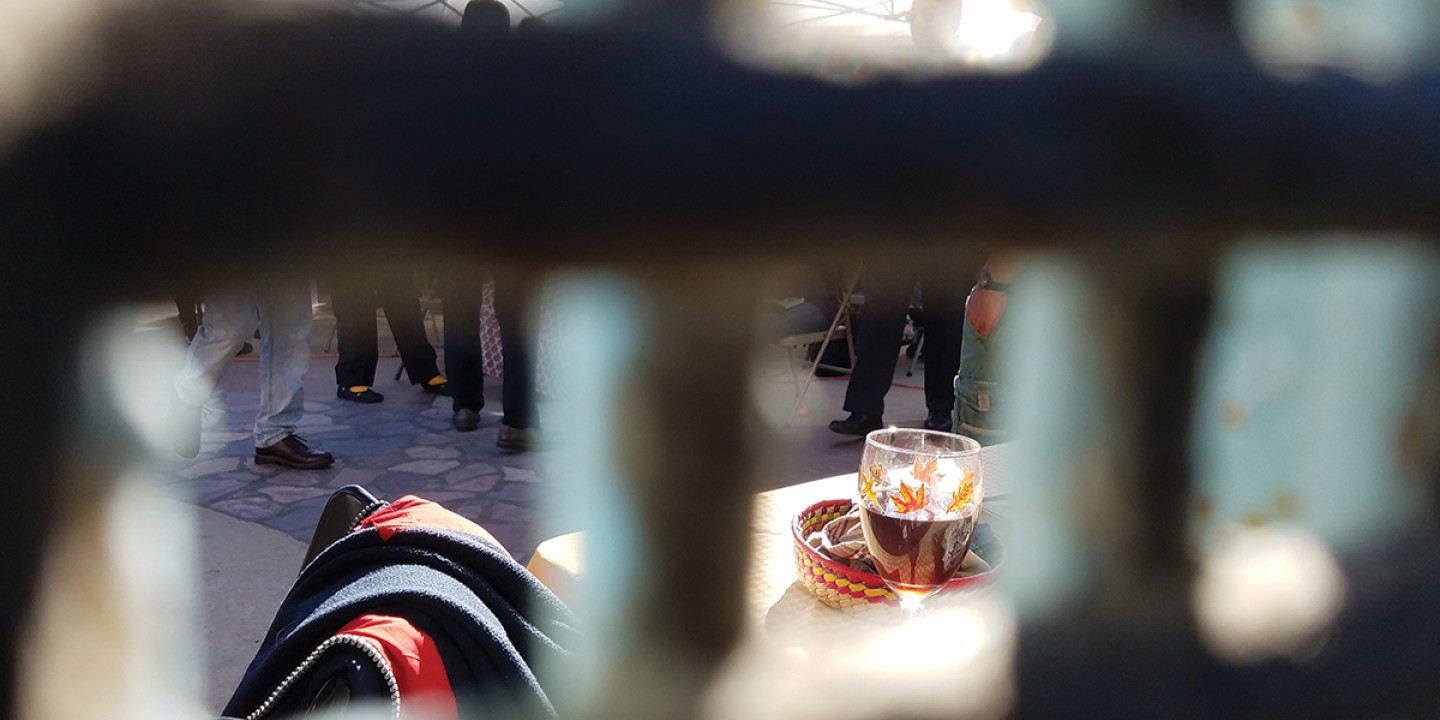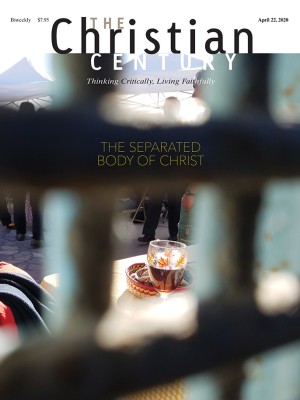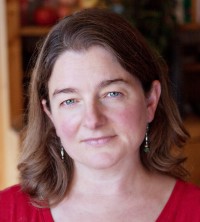A congregation that spans the US-Mexico border
For more than a decade, Christians have worshiped together across the border wall.

For the better part of a decade Christians have met to share a communion meal across the US-Mexico divide south of San Diego. This meeting has gone through many permutations through the years, and I was curious to see it up close. The only route to the border site begins at a state park that was off the beaten path, several turns down dirt roads into what seemed like wilder and wilder country.
When a friend and I pulled into the sandy parking lot that the internet had told us was the meeting place for the border church, our Uber driver was reluctant to leave us. There was no sign of church or church people. As we pondered what to do, we saw a man coming out of the weeds near a dumpster. I decided to ask him about the church. As I walked up to him, I noticed his long, ZZ Top beard and a baseball bat in his hand. “Hello,” I said. “We are looking for the border church. Do you know anything about it?”
Read our latest issue or browse back issues.
To my surprise, he said, “Oh yeah.” He glanced around the parking lot. “I don’t see John’s car anywhere, but I saw a couple of church people on the trail. You just go that way.” He gestured toward the ocean. “Then you turn and you go that way.” He pointed toward the border wall looming in the distance. “I’d call John for you,” he said, pulling a cracked pink phone out of his pocket and poking at it with his finger, “but I’m not getting any service.”
We let the Uber driver go and started to hike. San Diego had recently had some heavy rains, so many of the paths through the wild country were drowned in water. The only way to go was exactly the way the man with the baseball bat had directed us: to the edge of the water and then toward the border wall. As we walked, we saw no one. There was fresh horse dung on the trail, as if someone had recently been riding, but there were no other hikers, no church people ahead of us, nothing but sand and water and a massive steel structure that continued on into the ocean, as Alejandra Oliva says, “like the height of human folly—a literal line in the sand that’s been defended to the death, the starting point of an empire” (see “Communion at the border wall in Tijuana,” online only, February 6, 2019).
“John,” we knew, was John Fanestil, a Methodist pastor in San Diego, who had started meeting at the border fence in the binational Friendship Park more than a decade ago. At first, the group met for the traditional Las Posadas novena, singing to each other across the border about whether there was any room at the inn.
Then in 2008, the United States announced plans to build a more substantial barrier and to close Friendship Park, perhaps permanently. Fanestil and his friend Saul Montiel, another Methodist pastor, decided to share communion on both sides of the border (see “Border crossing,” October 7, 2008). They met at Friendship Park—Fanestil on the US side and Montiel on the Mexican side—but the Border Patrol warned them not to pass anything back and forth through the fence: to do so would be considered a violation of customs rules. In protest, and to dramatize the effect of such rules, the group eventually decided that only those on the US side would receive the bread and the juice, while those on the Mexican side went without.
Friendship Park is a round plaza, half a perfect circle on the Mexican side and half on the American side. A monument, now on the Mexican side, was erected in the 1850s to mark the border. (It was replaced in the 1890s.) A border fence was built in the 20th century, but for many years it was possible to pass gifts back and forth through the durable metal grate. Someone on the US side could even buy a tamale from someone on the Mexican side. Families met there for decades.
These family gatherings were blocked starting in 2009, when the US government seized the land from the state of California in order to erect an impermeable barrier. Fanestil and Montiel decided that if the government was going to kick the families out, it was going to have to kick the church out too. The government doubled down on its efforts to keep the church from meeting. Border Patrol agents waited on the beach for church attendees to arrive and then lined up to create a human wall to prevent the gathering. They detained participants but did not charge them. Eventually the government declared the area a construction zone, and the church did not meet for two years.
In 2011, with construction of the new barrier completed, the government opened the park for families between 10 a.m. and 2 p.m. on Saturdays and Sundays. Fanestil and others decided to restart the border church. By then Montiel had been reassigned to Los Angeles, and the future of the border church was unclear.
Enter Guillermo Navarrete, a Methodist layperson on the Mexican side of the border. He started to meet Fanestil at the border on Sundays. Eventually he brought others, then a sound system, then a feast to follow the service. Under Navarrete’s leadership the border church became what Fanestil calls a “fully dimensional church.” They meet in small groups to study and pray together; they provide support to migrantes y deportantes. On the Mexican side, the number of attendees frequently has been 50 or more, with people traveling from all over the world to participate.
On the US side, the effort is necessarily smaller. During much of the year, reaching Friendship Park requires a two-mile hike. In 2019, the Border Patrol decided that only ten people at a time would be allowed into the park—the number had been 40—and agents have been known to arbitrarily prevent people from entering the area.
The man with the baseball bat whom we met in the parking lot wasn’t John the Baptist or an angel. His name is Richard Vargas, and Fanestil calls him the church’s most regular attendee. He lives less than a mile away from Friendship Park and frequently walks his dog at Border Field State Park. An active supporter of the church, Vargas provides real-time reports of conditions on the ground and participates in the church’s social media efforts.
Before the coronavirus outbreak, there were several clergy sharing what they call “church in a backpack.” They would hike to Friendship Park on Sundays with a paten, a chalice, grape juice, bread, and a small sound system. A few years ago Dustin Craun, of the San Diego chapter of the Council on American-Islamic Relations, heard about the border church. He wanted to connect Muslim experience in the United States with the broader issues of borders and xenophobia and create a “prayer beyond borders.” This resulted in a Muslim call to prayer, led on the Mexican side by a group of Muslim women called the Latina-Muslim Foundation, taking place just before the Christian service.
The prohibition against passing food and drink through the fence has not prevented the border church from meeting. The tradition evolved, developing what Fanestil calls a “sacramental solidarity” approach: parallel Eucharists on each side of the border simultaneously. When the chain-link fence gave way to a steel and concrete barrier, worshipers continued passing the peace across the border—pinky to pinky through tiny holes in the new wall.
On the day in November when I visited, the sky was clear and the wind off the water robust. We found a good hard place to walk on the sand. But when we approached the wall, we still didn’t see Friendship Park or any church or even any people. But then we saw two Border Patrol agents standing next to a van. “Let’s ask them,” I said to my companion. We started up a hill toward them, and they waved us away. “But I want to ask you a question!” I yelled from the bottom of the hill. They continued waving us away. We went up the hill another way and found ourselves face-to-face with the two agents. “We are looking for the church,” I yelled at a distance. They allowed us to approach.
The “church” was right in front of us. We could see the small enclosure that is Friendship Park, and we could see the border wall. We saw a man and a woman, both in stoles, and another woman standing with them. A man in a Muslim kufi (prayer cap) stood near by. There were also two families that had gathered at the wall and were talking with relatives on either side.
The rule, one of the agents told us, was that only ten people could be in Friendship Park at a time. We would make 12. But he said that since we were there for the church, if we would just stand over on the less occupied side of the park, he would let us in.
The service had already begun. We peered through the tiny holes, surprised to see dozens of people gathered on the Mexican side of the border. There were Americans as well as Mexicans. There was a Unitarian group, all wearing gold-
colored shirts that said, “On the side of love.” There were tourists and migrants. Compared to them, our side was lonely and austere.
The bread was an ordinary sandwich loaf. The five of us worshipers on our side shared it, along with any of the family members who wanted to partake. They had carried on in the midst of the church service as if they were meeting at an ordinary park on an ordinary Sunday. One group was huddled together on the far end, engrossed in what seemed to be an intense and intimate conversation. The other group chatted and teased each other and talked at length, holding up the children to say hello.
After the park reopened in 2011, the church met week after week—no matter the condition of the border wall or fence, no matter the state of US-Mexico relations or the migrant crisis. Border church became more than a protest—it became an institution.
If the Border Patrol wouldn’t allow the two sides to get close enough to hear each other’s words, they would just call each other and hold the service by cell phone while standing just 50 feet apart. The church has had to handle rule changes without notice, like the day that it was announced that only ten people would be allowed in Friendship Park instead of 40. Once, Tom Davis, the presider at the service on the US side the day we were there, arrived at church to see a group of 12 people swimming around the ocean end of the wall to turn themselves in to seek asylum. Border church has met during the Bush, Obama, and Trump administrations. Now, during the coronavirus outbreak, with Friendship Park closed on the US side, the border church continues to meet via Zoom and Facebook Live, including a “virtual hike” to the border.
As we stood on our side and heard the words of institution, I felt the conflict at the border transposed into another register. I couldn’t help but think at once of this tiny moment and of all of human history. Time expanded. The conflict became all conflicts. The hubris and folly, all of human hubris and folly. The things that divided us became all divisions created by fear and the politics of fear. Davis must have been thinking something similar, or at least his words brought mine into clarity, because he prayed about the vastness of the sky under which we stood and the vastness of the water next to us as reminders of our small place in creation.
As we passed the peace pinky to pinky, I noticed a man on the other side who was wearing a Mexico soccer jersey and was pressed up right against the wall. We touched pinkies. Later, I stood near him while the benediction was being said. There were tears in his eyes, so there were also tears in mine. In English he asked where I was from. I said Colorado. I asked where he was from, and he said Guadalajara—almost 1,500 miles from Tijuana. By this I guessed that he was a deportee, though I didn’t know that for a fact. It was strange to cry together on either side of the wall without knowing each other’s stories. I imagined that he was separated from family, from people he loved, from the life he once had. I didn’t ask his story, and the park was closing soon. We would have to begin the hike back.
Fanestil later confirmed my instinct. He told me that many deportees come to the border church to experience a moment of connection across the border. He told me of a mother who lives in a shelter in Tijuana. She was deported from North Carolina, but her two children still live there. Coming to the border church was a way for her to reach out.
We began the hike back with our new acquaintances, Tom and Jeri Davis, both Methodist pastors, and Irene, a graduate student from Claremont Graduate Union who, like us, had read about the border church and decided to check it out. We walked along the ocean on one side. On the other side a helicopter lifted off and flew low over us.
Fanestil says that sacramental solidarity involves following the lead of migrant people. Their persistence, constancy, and determination, their ability to withstand injustice and suffering, form the foundation of the church. Fanestil says that he has learned the value of constancy from them. “Showing up is just how it works,” he says.
The work of the border church includes claiming the “true nature of the border,” Fanestil says. The federal government wants to mark the border as a place of crime and danger and fear. “We know it as a place of encounter, exchange, friendship, fellowship. We try to show up weekly in order to show what the border is truly.” While the coronavirus has put this weekly in-person meeting on hiatus, the true identity continues to be claimed, on both sides of the border.
A version of this article appears in the print edition under the title “Worship through a wall.”







